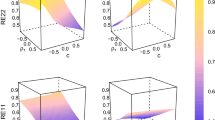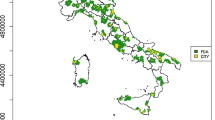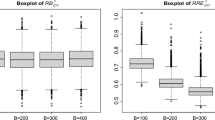Abstract
This paper introduces a small area estimation approach that borrows strength across domains (areas) and time and is efficiently used to obtain labour force estimators by economic activity. Specifically, the data across time are used to select different models for each domain; such selection is done with an aggregated mixed generalized Akaike information criterion statistic which is obtained using data across all time points and then is split into individual component for each domain. The approach makes a selection from different estimators, including the direct estimator, synthetic and mixed estimators derived from different models using auxiliary information. Results from several simulation experiments, some with original designs, show the good performance of the approach against standard small area approaches. In addition, it is shown the important practical advantages in the real application.











Similar content being viewed by others
References
Akaike H (1973) Information theory and the maximum likelihood principle. In: International symposium on information theory, Budapest. Akademiai Kiado, pp 267–281
Chetverikov D, Santos A, Shaikh AM (2018) The econometrics of shape restrictions. Annu Rev Econ 10:31–63
Eurostat (2008) Nace rev. 2. Statistical classification of economic activities in the European community. European Commission
Eurostat (2013) Manual on regional accounts methods. European Commission
Fay R, Herriot R (1979) Estimates of income for small places: an application of James-Stein procedures to census data. J Am Stat Assoc 70:311–319
Ghosh M, Rao J (1994) Small area estimation: an appraisal. Stat Sci 9:55–93
González-Manteiga W, Lombardía M, Molina I, Morales D, Santamaría L (2008) Analytic and bootstrap approximations of prediction errors under a multivariate Fay–Herriot model. Comput Stat Data Anal 52:5242–5252
Greven S, Kneib T (2010) On the beahviour of marginal and conditional Akaike information criteria in linear mixed models. Biometrika 97:773–789
Hall P, Maiti T (2006) On parametric bootstrap methods for small area prediction. J R Stat Soc Ser B 68:221–238
Han B (2013) Conditional akaike information criterion in the Fay–Herriot model. Stat Methodol 11:53–67
Jiang J (2010) Large sample techniques for statistics. Springer, New York
Jiang J, Lahiri P (2006) Mixed model prediction and small area estimation. Test 15(1):1–96
Jiang J, Lahiri P, Nguyen T (2018) A unied monte-carlo jackknife for small area estimation after model selection. Ann Math Sci Appl 3(2):405–438. https://doi.org/10.4310/AMSA.2018.v3.n2.a2
Kato K (2009) On the degrees of freedom in shrinkage estimation. J Multivar Anal 100:1138–1352
Lombardía M, López-Vizcaíno E, Rueda C (2017) Mixed generalized Akaike information (xgaic) for small area models. J R Stat Soc Ser A 180:1229–1252
Lombardía M, López-Vizcaíno E, Rueda C (2018) Selection of small area estimators. Stat Appl 16(1):269–288
Marhuenda Y, Morales D, Pardo M (2014) Information criteria for Fay–Herriot model selection. Comput Stat Data Anal 70:268–280
Muller S, Scealy J, Welsh A (2013) Model selection in linear mixed models. Stat Sci 28(2):135–167
Opsomer J, Claeskens G, Ranalli M, Kauermann G, Breidt F (2008) Non-parametric small area estimation using penalized spline regression. J R Stat Soc Ser B 70:265–286
Pfeffermann D (2002) Small area estimation. new developments and directions. Int Stat Rev 70:125–143
Pfeffermann D (2013) New important developments in small area estimation. Stat Sci 28:40–68
Rao J (1999) Some recent advances in model-based small area estimation. Surv Methodol 25:175–186
Rao J (2003) Small area estimation. Wiley, New York
Rao J, Molina I (2015) Small area estimation. Wiley, New York
Rao J, Yu M (1994) Small area estimation by combining time series and cross sectional data. Can J Stat 22:511–528
Robertson T, Wright F, Dykstra R (1988) Order restricted statistical inference. Wiley, New York
Rueda C (2013) Degrees of freedom and model selection in semiparametric additive monotone regression. J Multivar Anal 117:88–99
Rueda C, Menéndez J, Gómez F (2010) Small area estimators based on restricted mixed models. TEST 19:558–568
Tibshirani RT, Taylor J (2012) Degrees of freedom in Lasso problems. Ann Statistic 40(2):1198–1232
Ugarte M, Goicoa T, Militino A, Durbán M (2009) Spline smoothing in small area trend estimation and forecasting. Comput Stat Data Anal 53:3616–3629
Vaida F, Blanchard S (2005) Conditional Akaike information for mixed-effects models. Biometrika 92:351–370
Wagner J, Munnich R, Hill J, Stoffels J, Udelhoven T (2017) Nonparametric small area models using shape-constrained penalized b-splines. J R Stat Soc Ser A (Stat Soc) 180:1089–1109
Ye J (1998) On measuring and correcting the effects of data mining and model selection. J Am Stat Assoc 93:120–131
You C, Muller S, Ormerod J (2016) On generalized degrees of freedom with application in linear mixed models selection. Stat Comput 26:199–210
Author information
Authors and Affiliations
Corresponding author
Additional information
Publisher's Note
Springer Nature remains neutral with regard to jurisdictional claims in published maps and institutional affiliations.
Supported by the MINECO Grants MTM2017-82724-R, MTM2015-71217-R, and by the Xunta de Galicia (Grupos de Referencia Competitiva ED431C-2016-015 and Centro Singular de Investigación de Galicia ED431G/01), all of them through the ERDF.
Electronic supplementary material
Below is the link to the electronic supplementary material.
Rights and permissions
About this article
Cite this article
Lombardía, M.J., López-Vizcaíno, E. & Rueda, C. Selection model for domains across time: application to labour force survey by economic activities. TEST 30, 228–254 (2021). https://doi.org/10.1007/s11749-020-00712-4
Received:
Accepted:
Published:
Issue Date:
DOI: https://doi.org/10.1007/s11749-020-00712-4
Keywords
- Akaike information criterion
- Bootstrap
- Fay–Herriot model
- Generalized degrees of freedom
- Monotone model
- Small area estimation
- Spline regression




